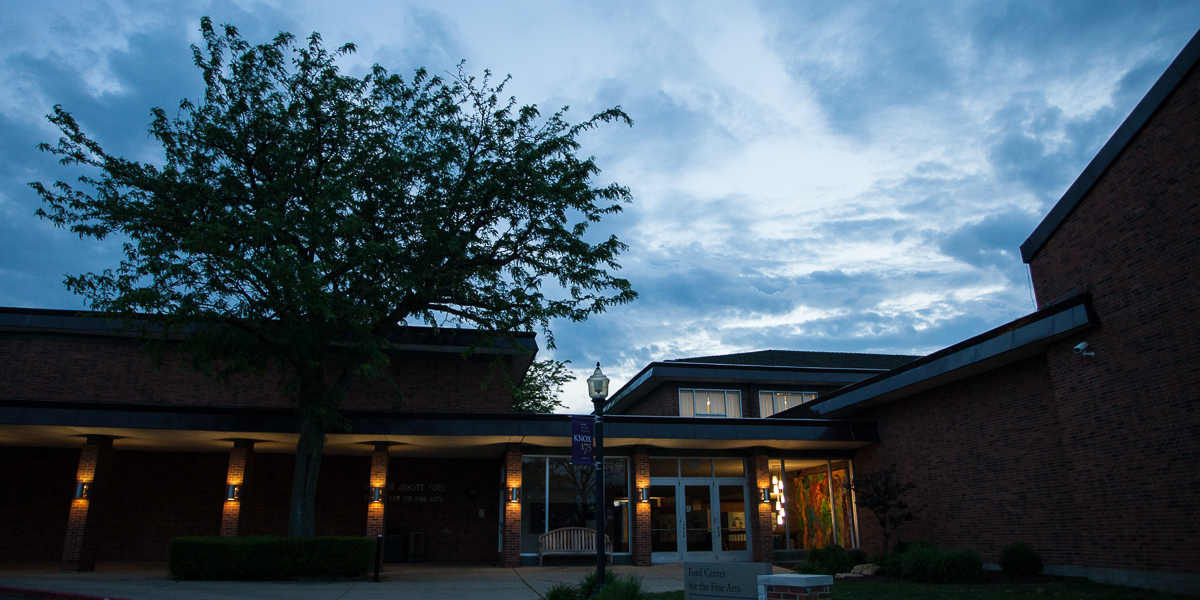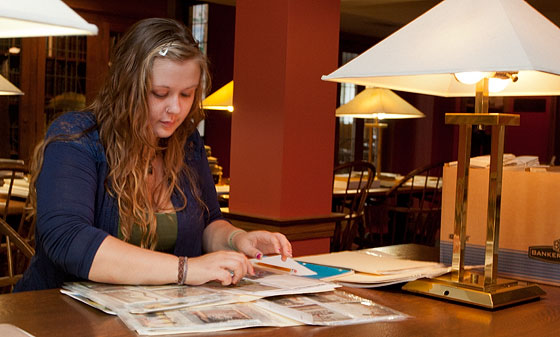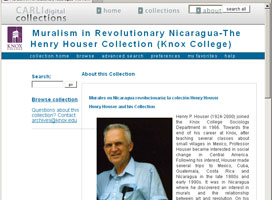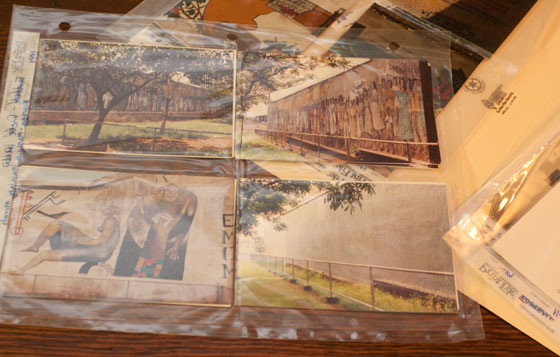

Venture Boldly

Office of Communications
2 East South Street
Galesburg, IL 61401


Rose Worthen's senior research project was already waiting for her, when she came to Knox College in 2007. The raw materials for the project -- boxes of photographs, documents and notes on murals in Nicaragua -- had mysteriously appeared several years earlier at the College's Seymour Library.
 "We did not know who brought the materials," said Knox College Archivist Carley Robison. "It was on a weekend, and someone dropped them off at the main desk. The student who was working at the desk didn't get a name."
"We did not know who brought the materials," said Knox College Archivist Carley Robison. "It was on a weekend, and someone dropped them off at the main desk. The student who was working at the desk didn't get a name."
Robison said they were able to determine that it was the work of Henry Houser, a retired professor of sociology at Knox who died in 2000. During the 1990s, Houser photographed dozens of murals in Nicaragua celebrating the 1979 Sandinista revolution that deposed dictator Anastasio Somoza.
"I knew the project would take a special person, someone with language skills, also knowledge of Latin American history," Robison says. "I thought it might be a job for a graduate student, someone with experience."
That "special person" turned out to be a first-year Knox student, Worthen, who applied for a student job in the College's Special Collections and Archives shortly after she arrived at Knox in 2007. "Because I knew Spanish, Carley said she had a project for me," Worthen recalls.
"First I started to learn my way around the Archives," says Worthen, who came to Knox from Helena, Montana. Among her early work in Archives was an inventory of Biblical manuscripts. For most of her sophomore year, Worthen studied at Knox's programs in Buenos Aires, Argentina and Barcelona, Spain. She also traveled to Chile and Peru.
"Spring term of my sophomore year, I started going through the murals," Worthen says. In Nicaragua, Houser had photographed about 120 murals, interviewed some of the artists, and collected news articles and documents.
"This is a unique collection, and it took a unique set of skills," Robison says. "We try to suit the task to the student -- based on the amount that a student is willing to do. Rosie was always willing to take the next step, to make it her project."
After cataloging the pictures and documents, Worthen digitized the images. About half of the images in the Henry Houser Manuscript Collection and Worthen's captions have been archived on-line by CARLI -- the Consortium of Academic and Research Libraries in Illinois.
 The murals create "a timeline of Nicaraguan history, themes and symbols," says says Worthen, who graduated from Knox cum laude with a double major in Integrated International Studies and Spanish. "Some images are anti-US -- American Marines occupied Nicaragua in the 1930s, and in the 80s the U.S. supported 'Contra' paramilitaries against the Sandinista government. Not all are political, some are religious, and others show kids running with a kite or women learning how to read."
The murals create "a timeline of Nicaraguan history, themes and symbols," says says Worthen, who graduated from Knox cum laude with a double major in Integrated International Studies and Spanish. "Some images are anti-US -- American Marines occupied Nicaragua in the 1930s, and in the 80s the U.S. supported 'Contra' paramilitaries against the Sandinista government. Not all are political, some are religious, and others show kids running with a kite or women learning how to read."
The Nicaraguan murals have been compared to 20th century political murals in Mexico and Chile. "But there's nothing like the murals in Nicaragua, spread over so many themes -- literacy, children, agrarian themes, religious themes," Worthen says.
The murals are both public art and a form of communication, Worthen says. "The literacy rate was low. This was a way to talk to people who couldn't read. Not just pictures on the wall -- they're a part of the country's history."
They're also disappearing, Worthen says. "After the Sandinistas lost the election in 1990, the mayor of Managua launched a campaign to paint over the murals." Houser got involved in efforts to preserve them, Worthen says, giving talks in the region through the Peoria Peace Network and donating his speaking fees toward fundraising for artists in Nicaragua to continue painting and restoring murals.
"This is just incredible work to photograph the murals and interview artists, plus he took an active stance to protect them," Worthen says. "They are so amazing, I want to show them to everyone. It makes me feel very special, very lucky, to work with these. Now, his photos may be the only proof that these murals existed."
 Henry Houser's Nicaragua mural photos and Rose Worthen annotations can be browsed at the CARLI website.
Henry Houser's Nicaragua mural photos and Rose Worthen annotations can be browsed at the CARLI website.
Worthen's multi-year effort served as the "capstone project" for her major in Integrated International Studies.
"Rosie's work is a great example of what the capstone can be," said Karen Kampwirth, professor of political science and chair of Knox's Latin American Studies Program. "Her research on the murals allowed her to combine her general interests in Latin American politics and culture with her specific work on the murals that Henry Houser photographed.
"While the project was on one country, it turned out to be about globalization in all sorts of ways," Kampwirth says. "One of the major themes of the murals was the effort of Nicaraguans to resist the often violent domination of their country by the United States government. Also many of the muralists were artists from other countries who went to Nicaragua to make murals with local people as a way of supporting the Sandinista Revolution."
After graduating from Knox in June, Worthen was awarded a post-baccalaureate fellowship for the current academic year. The fellowship combines academic work with a service project -- Worthen will add more pages to the on-line collection while working as a tutoring coordinator for Knox's TRIO Achievement Program and participating in a community research project -- the Knox Prairie Community Kitchen. During her senior year she helped organize the Lunch Spot program that provided meals to local school children during winter break.
When she visited Nicaragua late last year, Worthen said she found one mural that's not part of Houser's collection. "It's a dream of mine to go back and see some of the murals pictured."
To gain permission to publish the photographs, Worthen contacted Houser's family and eventually discovered how the collection came to the College. "We learned later that it was one of Professor Houser's daughters, Nancy Houser Brazil, who had left the material at the library," Robison said. "Professor Houser's children -- Nancy Houser Brazil, Barbie Houser Butler and Greg Houser -- have been so positive. They knew how much this meant to their father."

Published on September 27, 2011